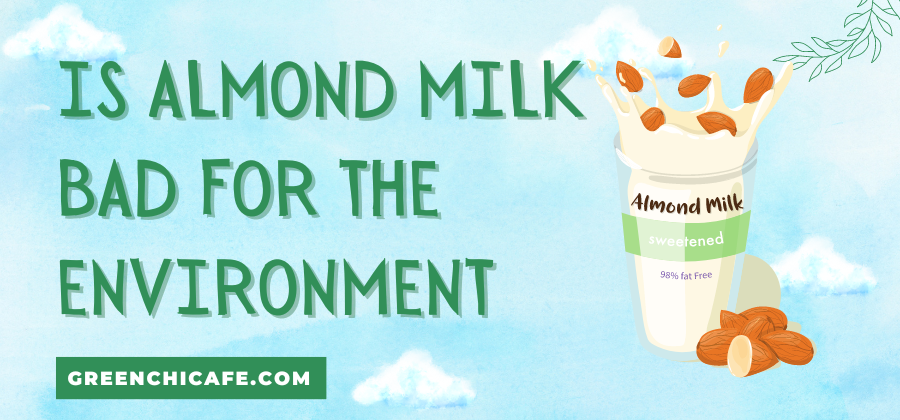Almond milk is rising in popularity due to being dairy-free, nutritious, and versatile.
But the main question is – how does its production affect the planet?
This article looks at the environmental impact of almond milk and how it compares to dairy milk.
Is Almond Milk Bad for the Environment?
Yes, the current production of almond milk has concerning environmental impacts.
Almond farming consumes substantial amounts of water in drought-prone California and contributes to fertilizer pollution.
Large areas of natural habitat have also been converted to almond orchards, disrupting ecosystems.
Additionally, the global transportation and packaging of almond milk products emit greenhouse gases.
More efficient farming techniques and sustainable practices could help reduce almond milk’s footprint.
But at current production levels, almond milk cannot be considered eco-friendly.
Key Points
- Almond farming in California uses intensive irrigation, harming habitats
- Over 100 liters of water are needed per liter of almond milk
- Almond orchards replace grasslands and oak woodlands
- Global transportation of almond milk emits greenhouse gases
Is Almond Milk Bad for the Environment? How It is Produced
The production process of almond milk starts with growing almonds.
California produces 80% of the world’s almonds using intensive farming methods.
Orchards rely heavily on synthetic nitrogen fertilizers, which contribute to greenhouse gas emissions.
Pesticides are also used extensively, causing harm to ecosystems.
Once almonds are harvested, they soak in water before being ground into milk.
But almonds are water-intensive crops, requiring more water per nut than other nuts.
Droughts have threatened California’s almond industry, raising questions over the crop’s long-term viability.
After being strained, almond milk is bottled and shipped across the country and the world.
This transportation results in fossil fuel emissions. Overall, the production process uses significant amounts of water and energy.
Water Usage Compared to Dairy Milk
A major sustainability concern with almond milk is its high-water usage.
Almond milk requires over 100 liters of water to produce one liter of milk.
In drought-prone California, this water footprint is alarming.
In comparison, around 1000 liters of water is needed to produce one liter of cow’s milk.
So, almond milk uses less water overall, but still a substantial amount in areas facing water scarcity.
More research is needed on almond farming methods that optimize water use efficiency.
But currently, almond milk’s high water requirements in water-stressed regions are worrying.
Land Usage and Impacts on Ecosystems
The spread of almond orchards is linked to wide-scale environmental degradation in California.
Intensive almond farming has replaced grasslands and oak woodlands, devastating native wildlife.
Bee colonies are also brought to pollinate almond trees, raising concerns over diseases.
Almond orchards have expanded rapidly, with cultivated land doubling in California between 2008 to 2015.
This land conversion has severely impacted natural ecosystems and biodiversity.
In contrast, the land needed to rear dairy cows causes less direct environmental damage.
But methane emissions from cattle contribute heavily to their impact.
Overall, both almond and dairy farming change landscapes and disrupt wildlife.
Greenhouse Gas Emissions
Almond milk results in more greenhouse gas emissions over its lifecycle compared to dairy milk.
The carbon footprint of one glass of almond milk is around 0.7 kg CO2 equivalent.
Whereas one glass of dairy milk is estimated to be 1.1 kg CO2 equivalent.
However, methane emissions from cows account for the dairy industry’s higher total emissions.
Overall, both almond and dairy milk contribute to climate change, but through different pathways.
More efficient farming practices and renewable energy use during processing could reduce almond milk’s carbon footprint.
But currently, its emissions are a downside.
Use of Fertilizers and Pesticides
Heavy use of synthetic fertilizers and pesticides is concerning from an environmental standpoint.
Almond farms apply high levels of nitrogen fertilizers, causing nitrogen pollution in waterways and emissions.
Pesticide use also affects biodiversity and species like bees.
In contrast, organic almond farms use fewer chemicals.
But yields are lower, requiring more land to produce the same milk volume.
So, a complete shift to organic almond farming may not be realistic yet.
Ultimately, reducing fertilizer and pesticide inputs should be a priority.
But this requires innovations in almond farming techniques.
Is Almond Milk Recyclable and Biodegradable?
Almond milk packaging is widely recyclable, including cartons and bottles.
However, recycling systems vary, so recyclability depends on local infrastructure.
On the other hand, most plastic milk bottles end up in landfills.
In terms of biodegradability, almond milk has an advantage over dairy milk.
Plant-based milk will break down naturally over time if sent to landfills or composts.
But dairy milk takes decades to decompose due to plastic coatings in cartons.
Overall, almond milk packaging creates less environmental waste.
But improving recycling and composting systems for all beverage cartons is needed.
Is Almond Milk Ethical and Sustainable?
There are ethical concerns with almond milk relating to beekeeping practices.
Some commercial beekeepers may use unethical techniques to produce strong bee colonies for pollinating almonds.
This raises animal welfare issues.
However, the almond industry emphasizes sustainability initiatives and stewardship programs for farmers.
With more oversight and standards, almond farming could become an ethical and eco-friendly crop.
Ultimately, almond milk has advantages but also downsides for the planet.
In moderation, it can be part of a sustainable diet, but from an environmental standpoint, it is not perfect.
As with any food production, reducing waste, inputs, and emissions should be the goal.
How does almond milk affect us?
The environmental impacts of almond milk production ultimately affect human well-being too.
Almond farming consumes significant amounts of water in drought-prone regions, leaving less water for community use.
Runoff from nitrogen fertilizers pollutes drinking water, posing a health risk.
Pesticides used on almond orchards also drift into neighboring towns, impacting air quality.
Intensive almond monocropping degrades soil health over time, reducing the agricultural productivity that communities depend on.
Habitat loss from expanding orchards also removes natural areas where people recreate and connect with nature.
And the overall contributions of almond farming to climate change affect human society everywhere through weather disruptions, heatwaves, rising sea levels, and more.
Essentially, the unsustainable practices involved in making most almond milk on the market today harm people and communities in myriad ways.
More mindful and regenerative almond production is needed.
What environment is most affected by plastic pollution?
The marine environment is most severely affected by plastic pollution from almond milk and other drink cartons.
Up to 12.7 million tons of plastic enter the ocean each year, with beverage packaging comprising a significant portion.
Cartons contain layers of plastic and aluminum that take decades to break down in the ocean.
This plastic waste harms seabirds, fish, turtles, and marine mammals through ingestion and entanglement.
Over 700 marine species are known to be threatened.
Additionally, plastic releases harmful chemicals that accumulate up the food chain.
Plastic also inefficiently transports invasive species across oceans.
Overall, the marine ecosystem is bearing the brunt of plastic waste pollution from consumer packaging like almond milk cartons.
Recycling and eliminating single-use plastics are crucial for protecting oceans.
How can almond milk be more environmentally sustainable?
Several steps can help improve the sustainability of almond milk and reduce its environmental footprint:
- Switching to drip irrigation systems that optimize water usage and avoid runoff. Currently, many almond farms flood and irrigate, which wastes water.
- Allowing almond orchard groundcover plants to grow to enhance soil health, rather than bare ground tilling practices.
- Using compost and manure fertilizers instead of synthetic nitrogen fertilizers that pollute waterways.
- Intercropping almond trees with other plants to increase biodiversity.
- Rotating almond crops with other less water-intensive crops to give the soil a break.
- Planting native vegetation barriers near orchards to prevent pesticide drift.
- Prioritizing renewable energy like solar instead of fossil fuels during almond milk production.
- Focusing on local sales and reducing transportation emissions.
With research and initiative from farmers, almond farming can move in a more regenerative direction.
Key Takeaways: Is Almond Milk Bad for the Environment?
While almond milk has some benefits over dairy milk, such as lower greenhouse gas emissions overall and better biodegradability, there are significant environmental concerns related to its production:
- High water usage for growing almonds in drought-stricken California
- Impacts of fertilizers and pesticides on ecosystems and biodiversity
- Land conversion for almond orchards disrupting native wildlife
- Intensive farming methods required to meet demand
- Transportation emissions from national and global distribution
However, with more efficient farming techniques and better waste systems, almond milk could become part of a sustainable food system.
But currently, consumers should be aware of its environmental footprint. Moderating intake and buying from eco-conscious brands can help enjoy it guilt-free!
Frequently Asked Questions
What is the environmental impact of almond farming?
Almond farming has wide-ranging environmental impacts, including habitat loss, fertilizer runoff, pesticide usage, soil erosion, and water usage. In California, almond orchards have rapidly expanded by converting grasslands and woodlands into agricultural land. This disrupts native species and ecosystems. Almond farms also apply nitrogen fertilizers at very high rates, causing water pollution. Pesticides used on almond trees affect pollinators and other wildlife. Soil health declines under continuous almond monocropping as well. Overall, intensive almond farming damages biodiversity and natural resources.
Does almond milk consume more water than dairy milk?
Yes, almond milk has a higher water footprint compared to dairy milk. Around 371 liters of water is needed to grow almonds for one liter of almond milk. In comparison, between 287 to 1027 liters of water is used in the production cycle of one liter of cow’s milk. However, almond milk still consumes substantial amounts of water in drought-sensitive California. More efficient irrigation and farming methods could reduce almond milk’s water usage.
Is almond milk packaging recyclable?
Most almond milk cartons consist of recyclable materials like cardboard and plastic. Look for recycling symbols on almond milk packages to determine if curbside pickup is available in your neighborhood. Some brands also use recyclable glass bottles. However, recycling systems vary locally, so recyclability ultimately depends on your city’s waste infrastructure. Always try to recycle or compost almond milk containers when possible.
Are there more sustainable brands of almond milk?
Some almond milk producers focus on eco-friendly practices, like using renewable energy, efficient irrigation, and recyclable packaging. Choosing these sustainable brands, even if slightly more expensive, helps reduce the environmental impact. Additionally, buying locally produced almond milk saves on transportation miles. Organic options also use fewer pesticides, despite lower yields. With more awareness and demand, sustainable almond farming can expand.
At GreenChiCafe, we are passionate about the environment and a sustainable future. Check out our website for more tips on green living and eco-friendly choices that benefit the planet!

Annie is a passionate environmental writer and activist. She has been writing about sustainability, conservation, and green living for over 15+ years. Annie is dedicated to raising awareness about environmental issues and providing practical tips for living an eco-friendly lifestyle. When she’s not writing, you can find her volunteering with local environmental organizations, teaching workshops on zero waste living, or exploring nature. Feel free to get in touch with Annie: annie@greenchicafe.com


